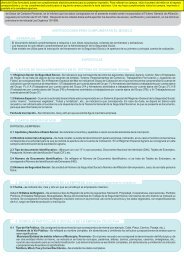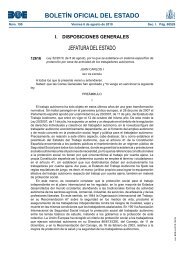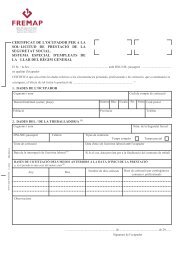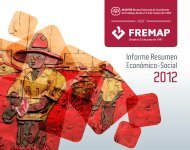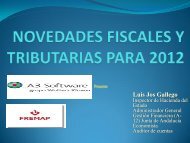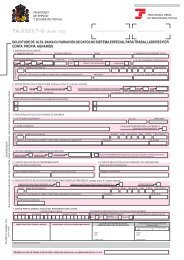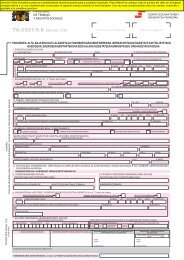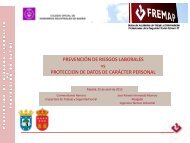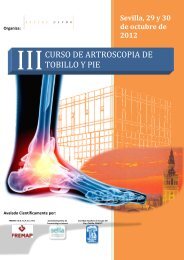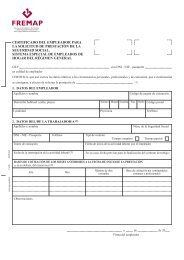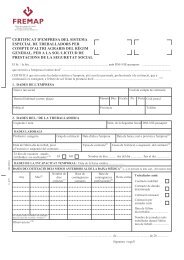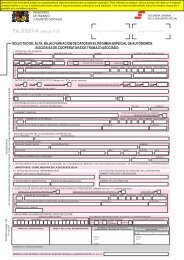Guide to Health and Safety in - Fremap
Guide to Health and Safety in - Fremap
Guide to Health and Safety in - Fremap
You also want an ePaper? Increase the reach of your titles
YUMPU automatically turns print PDFs into web optimized ePapers that Google loves.
<strong>Guide</strong> <strong>to</strong> <strong>Health</strong> <strong>and</strong> <strong>Safety</strong> <strong>in</strong><br />
Kitchens, Bars <strong>and</strong><br />
Restaurants
Contents<br />
• Foreword .................................................................................. 4<br />
3<br />
Page<br />
• Ma<strong>in</strong> Risks <strong>and</strong> General Preventive Measures<br />
- Tid<strong>in</strong>ess <strong>and</strong> Cleanl<strong>in</strong>ess <strong>in</strong> the Workplace ............................ 8<br />
- Manual H<strong>and</strong>l<strong>in</strong>g of Heavy Objects ....................................... 9<br />
- Electrical <strong>Safety</strong> <strong>Guide</strong>l<strong>in</strong>es .................................................. 11<br />
- Risk of Explosion due <strong>to</strong> Gas Accumulation ............................ 12<br />
- H<strong>and</strong>l<strong>in</strong>g of Clean<strong>in</strong>g Products ............................................. 13<br />
• Risks <strong>and</strong> Specific Preventive Measures <strong>in</strong> Kitchens<br />
Workstations <strong>and</strong> Waiters Workplaces<br />
- Kitchens ............................................................................. 16<br />
- Waiters ..............................................................................<br />
• Hygienic-Sanitary Practices<br />
- Reception of Raw Materials <strong>and</strong> Ingredients:<br />
20<br />
Check<strong>in</strong>g of Supplies ...........................................................<br />
- S<strong>to</strong>rage <strong>and</strong> Conservation of Raw Materials<br />
22<br />
<strong>and</strong> Ingredients .................................................................. 23<br />
- Preparation of Raw Materials <strong>and</strong> Intermediate Products ...... 23<br />
- Cook<strong>in</strong>g of Foods ................................................................ 24<br />
- S<strong>to</strong>rage of Pre-Cooked Foods .............................................. 24<br />
- Reconstitution of Pre-Cooked Foods .................................... 25<br />
- Putt<strong>in</strong>g food on plates <strong>and</strong> Serv<strong>in</strong>g meals .............................<br />
• How <strong>to</strong> proceed <strong>in</strong> the event of an Emergency<br />
25<br />
- How <strong>to</strong> Proceed <strong>in</strong> the event of a Fire .................................... 28<br />
- Fire Types ........................................................................... 28<br />
- How <strong>to</strong> Proceed <strong>in</strong> the event of an Evacuation ....................... 29<br />
- How <strong>to</strong> Proceed <strong>in</strong> the event of an Accident ........................... 29<br />
- Cardiopulmonary Resucitation ............................................ 30<br />
- Bleed<strong>in</strong>gs ........................................................................... 31<br />
- Wounds <strong>and</strong> Burns .............................................................. 31<br />
- Fa<strong>in</strong>t<strong>in</strong>g <strong>and</strong> Convulsions .................................................... 32<br />
- Projected materials ............................................................ 32<br />
- Poison<strong>in</strong>g............................................................................ 33<br />
• Workers’ Obligations Regard<strong>in</strong>g Occupational Risk Prevention .... 36
Foreword<br />
Article 18 of the OCCUPATIONAL RISK PREVENTION ACT<br />
establishes the employer’s obligation <strong>to</strong> <strong>in</strong>form its workers about<br />
the risks that could affect their health <strong>and</strong> the prevention measures<br />
<strong>to</strong> be implemented <strong>to</strong> avoid them.<br />
This <strong>Guide</strong> has been published with this aim; for the purpose of<br />
<strong>in</strong>form<strong>in</strong>g workers employed <strong>in</strong> Kitchens, Bars <strong>and</strong> Restaurants<br />
sec<strong>to</strong>r of the most common risks <strong>to</strong> which they are exposed <strong>and</strong><br />
how they should act <strong>in</strong> order <strong>to</strong> prevent them.<br />
FREMAP Prevention Area hopes that this publication will help<br />
<strong>to</strong> improve health <strong>and</strong> safety st<strong>and</strong>ards <strong>in</strong> this sec<strong>to</strong>r.<br />
4
Basic Pr<strong>in</strong>ciples for prevent<strong>in</strong>g<br />
Occupational Accidents<br />
Know, underst<strong>and</strong> <strong>and</strong> put <strong>in</strong><strong>to</strong> practice all the emergency, prevention<br />
<strong>and</strong> safety guidel<strong>in</strong>es.<br />
Do not permit work methods that fall outside the scope of any <strong>Safety</strong><br />
rule that may be established.<br />
Immediately warn your superior of any condition or practice that<br />
could cause <strong>in</strong>juries.<br />
Do not wear r<strong>in</strong>gs, cha<strong>in</strong>s or bracelets or any element that could<br />
become hooked or trapped or be a focus, reservoir or vehicle for germs.<br />
All irregularities observed <strong>in</strong> the electrical <strong>in</strong>stallation <strong>and</strong> equipment<br />
must be reported <strong>to</strong> the person <strong>in</strong> charge immediately.<br />
When driv<strong>in</strong>g vehicles, take care <strong>to</strong> obey the road signs, take care<br />
of the vehicle <strong>and</strong> bear <strong>in</strong> m<strong>in</strong>d the rules on dr<strong>in</strong>k<strong>in</strong>g alcohol or<br />
tak<strong>in</strong>g medic<strong>in</strong>es while driv<strong>in</strong>g.<br />
Do not smoke, eat or dr<strong>in</strong>k <strong>in</strong> your workplace.<br />
5
MAIN RISKS AND GENERAL<br />
PREVENTIVE MEASURES<br />
7
MAIN RISKS AND GENERAL PREVENTIVE MEASURES<br />
Ma<strong>in</strong> Risks<br />
Tid<strong>in</strong>ess <strong>and</strong> Cleanl<strong>in</strong>ess <strong>in</strong> the Workplace<br />
Falls on the same level due <strong>to</strong> slipp<strong>in</strong>g <strong>and</strong> stumbl<strong>in</strong>g.<br />
Bump<strong>in</strong>g aga<strong>in</strong>st protrud<strong>in</strong>g objects occupy<strong>in</strong>g<br />
passageways.<br />
Fall<strong>in</strong>g of s<strong>to</strong>red objects <strong>and</strong> objects be<strong>in</strong>g h<strong>and</strong>led.<br />
Fires.<br />
Preventive Measures<br />
Tid<strong>in</strong>ess <strong>and</strong> Cleanl<strong>in</strong>ess <strong>in</strong> the Workplace<br />
All passageways, exits <strong>and</strong> escape routes must be ma<strong>in</strong>ta<strong>in</strong>ed clear <strong>and</strong> free from obstacles.<br />
S<strong>to</strong>red materials must not block access <strong>and</strong> visibility with respect <strong>to</strong> emergency equipment (ext<strong>in</strong>guishers,<br />
fire hydrants, first aid posts,…).<br />
Close the doors of all cupboards, <strong>and</strong> drawers <strong>and</strong> other elements you might bump aga<strong>in</strong>st.<br />
Stacked materials must be stable <strong>and</strong> safe. If us<strong>in</strong>g shelves, make sure objects do not protrude from<br />
them. Heaviest objects must be placed on the lower shelves. When stack<strong>in</strong>g objects on the floor, the<br />
heaviest <strong>and</strong> bulkiest objects must go at the bot<strong>to</strong>m. Stack<strong>in</strong>g height limits must be respected <strong>to</strong><br />
guarantee the stability of the pile.<br />
Do not climb on<strong>to</strong> shelves, use ladders.<br />
In s<strong>to</strong>rage areas, keep corridors between the shelves clear.<br />
Use only the appropriate conta<strong>in</strong>ers for waste disposal, cardboard, rubbish, etc.<br />
Do not accumulate waste on the floor, mach<strong>in</strong>es or work tables. Use conta<strong>in</strong>ers provided for that<br />
purpose.<br />
Clean or mop up any spilled liquid or cover it immediately with an absorbent material.<br />
In pantries, kitchens or <strong>in</strong>side cold s<strong>to</strong>rage rooms verify regularly that dra<strong>in</strong>s are not blocked.<br />
8
MAIN RISKS AND GENERAL PREVENTIVE MEASURES<br />
Ma<strong>in</strong> Risks<br />
Manual H<strong>and</strong>l<strong>in</strong>g of Heavy Objects<br />
Back <strong>in</strong>juries due <strong>to</strong> stra<strong>in</strong>.<br />
Bump<strong>in</strong>g aga<strong>in</strong>st objects while replac<strong>in</strong>g s<strong>to</strong>ck<br />
<strong>in</strong> cold s<strong>to</strong>rage rooms <strong>and</strong> shelves<br />
Cuts <strong>to</strong> the h<strong>and</strong>s when h<strong>and</strong>l<strong>in</strong>g bottles.<br />
Fall<strong>in</strong>g of h<strong>and</strong>led objects.<br />
Preventive Measures<br />
Manual H<strong>and</strong>l<strong>in</strong>g of Heavy Objects<br />
Whenever possible, use auxiliary means <strong>to</strong> carry objects such as trays, trolleys etc., especially if they are<br />
heavy or bulky or need <strong>to</strong> be h<strong>and</strong>led often.<br />
If the object is <strong>to</strong>o heavy, or <strong>to</strong>o difficult <strong>to</strong> h<strong>and</strong>le, ask others for help.<br />
In operations <strong>in</strong>volv<strong>in</strong>g h<strong>and</strong>l<strong>in</strong>g waste bags, bottles <strong>and</strong> glass objects, before h<strong>and</strong>l<strong>in</strong>g the object use<br />
protective gloves, if you observe that the surface has sharp edges, nails, spl<strong>in</strong>ters, dirt, is damp or hot,<br />
etc., .<br />
Make sure you have enough room <strong>to</strong> h<strong>and</strong>le the object before lift<strong>in</strong>g it <strong>and</strong> check that the path is<br />
clear.<br />
Use ladders <strong>to</strong> reach small objects located above shoulders height <strong>to</strong> avoid h<strong>and</strong>l<strong>in</strong>g objects with your<br />
arms above your head. Never use boxes, chairs, s<strong>to</strong>ols, etc. as stepladders.<br />
9
MAIN RISKS AND GENERAL PREVENTIVE MEASURES<br />
Preventive Measures<br />
Manual H<strong>and</strong>l<strong>in</strong>g of Heavy Objects<br />
When h<strong>and</strong>l<strong>in</strong>g heavy objects adopt the correct postures <strong>and</strong> movements <strong>to</strong> avoid stra<strong>in</strong>. You must:<br />
Get as close <strong>to</strong> the object as possible.<br />
Keep your feet firmly planted <strong>and</strong> also keep them a shoulder width apart. If h<strong>and</strong>l<strong>in</strong>g an object from a<br />
high shelf br<strong>in</strong>g it close <strong>to</strong> the body obta<strong>in</strong><strong>in</strong>g a firmly <strong>and</strong> stable grip.<br />
Bend both knees keep<strong>in</strong>g your back straight.<br />
Lift the load us<strong>in</strong>g your legs muscles <strong>and</strong> not your back.<br />
Grasp the load tightly with both h<strong>and</strong>s.<br />
Keep the load close <strong>to</strong> your body while carry<strong>in</strong>g it, tak<strong>in</strong>g short steps.<br />
Preventive Measures<br />
Manual H<strong>and</strong>l<strong>in</strong>g of Heavy Objects<br />
When lift<strong>in</strong>g <strong>and</strong> twist<strong>in</strong>g, try <strong>to</strong> move<br />
your feet <strong>in</strong>stead of your waist.<br />
Avoid mak<strong>in</strong>g sharp movements with your<br />
back, especially twist<strong>in</strong>g movements, even<br />
when lift<strong>in</strong>g light loads.<br />
10
MAIN RISKS AND GENERAL PREVENTIVE MEASURES<br />
Ma<strong>in</strong> Risks<br />
Electrical <strong>Safety</strong> <strong>Guide</strong>l<strong>in</strong>es<br />
Direct electrical contacts with live conduc<strong>to</strong>rs.<br />
Indirect electrical contacts with metal parts<br />
or elements that become accidentally live.<br />
Burns from electrical arcs.<br />
Preventive Measures<br />
Electrical <strong>Safety</strong> <strong>Guide</strong>l<strong>in</strong>es<br />
Do not h<strong>and</strong>le electrical <strong>in</strong>stallations (electrical panels, the <strong>in</strong>terior of mach<strong>in</strong>es, etc.) if you are not<br />
tra<strong>in</strong>ed <strong>and</strong> authorised <strong>to</strong> do so.<br />
Before us<strong>in</strong>g the electrical equipment, check that the hous<strong>in</strong>g, cables <strong>and</strong> but<strong>to</strong>ns are not damaged.<br />
Do not use electrical equipment with wet h<strong>and</strong>s. Keep your feet dry <strong>and</strong> use the appropriate footwear<br />
accord<strong>in</strong>g <strong>to</strong> work<strong>in</strong>g conditions.<br />
Do not use cables, sockets or extension cords near s<strong>in</strong>ks <strong>and</strong> wet or damp zones.<br />
Do not make connections with stripped cables. Never modify or improvise connection p<strong>in</strong>s <strong>in</strong> electrical<br />
equipment.<br />
Do not overload sockets by plugg<strong>in</strong>g <strong>in</strong> <strong>to</strong>o many multiple connec<strong>to</strong>rs or term<strong>in</strong>al boards.<br />
Do not leave cables ly<strong>in</strong>g <strong>in</strong> passageways.<br />
In the event of a breakdown or malfunction, disconnect the <strong>to</strong>ol or equipment, put a sign <strong>in</strong>dicat<strong>in</strong>g<br />
the failure <strong>and</strong> report it <strong>to</strong> your supervisor.<br />
In the event of fire, do not throw water on a fire where there may be live elements.<br />
In the event of electrocution, proceed as follows:<br />
Switch off the current <strong>in</strong> all cases.<br />
Warn the medical emergency service <strong>and</strong> apply first aid immediately, if you are able <strong>to</strong>, do so.<br />
11
Ma<strong>in</strong> Risks<br />
Risk of Explosion due <strong>to</strong> Accumulation Gas<br />
Obstructed ventilation grilles.<br />
Liquids spilled on gas r<strong>in</strong>gs while cook<strong>in</strong>g food.<br />
Incorrect use or <strong>in</strong>correct switch on gas heaters <strong>and</strong><br />
ovens.<br />
Dirty or blocked gas r<strong>in</strong>gs.<br />
MAIN RISKS AND GENERAL PREVENTIVE MEASURES<br />
Preventive Measures<br />
Risk of Explosion due <strong>to</strong> Accumulation Gas<br />
At the end of the workday, check that all the gas s<strong>to</strong>pcocks are closed.<br />
Regularly <strong>in</strong>spect the state of the open<strong>in</strong>g controls <strong>to</strong> avoid leav<strong>in</strong>g them<br />
half open.<br />
Keep gas cyl<strong>in</strong>ders away from heat sources.<br />
When cook<strong>in</strong>g foods that could spill when boil<strong>in</strong>g, do not leave the<br />
kitchen <strong>and</strong> watch the pots.<br />
If you smell gas:<br />
– Close all the s<strong>to</strong>pcocks.<br />
– Ventilate the room.<br />
– Do not light flames.<br />
– Do not turn any electric switches on<br />
(<strong>in</strong>clud<strong>in</strong>g the smoke extrac<strong>to</strong>r switch).<br />
12
Ma<strong>in</strong> Risks<br />
H<strong>and</strong>l<strong>in</strong>g of clean<strong>in</strong>g products<br />
Accidental <strong>in</strong>gestion.<br />
Burns <strong>and</strong> sk<strong>in</strong> irritations.<br />
Splash<strong>in</strong>g <strong>in</strong><strong>to</strong> the eyes.<br />
Inhal<strong>in</strong>g <strong>to</strong>xic or harmful gases.<br />
MAIN RISKS AND GENERAL PREVENTIVE MEASURES<br />
Preventive Measures<br />
H<strong>and</strong>l<strong>in</strong>g of clean<strong>in</strong>g products<br />
Only pour clean<strong>in</strong>g products <strong>in</strong><strong>to</strong> appropriate conta<strong>in</strong>ers keep<strong>in</strong>g the label of the orig<strong>in</strong>al conta<strong>in</strong>er.<br />
Do not leave clean<strong>in</strong>g products (detergents, bleach, …) <strong>in</strong> household or kitchen conta<strong>in</strong>ers such as<br />
dishes, glasses, etc. even <strong>in</strong> small quantities. Always use marked conta<strong>in</strong>ers <strong>to</strong> avoid them enter<strong>in</strong>g<br />
<strong>in</strong><strong>to</strong> contact with food or dr<strong>in</strong>ks by mistake.<br />
Do not mix clean<strong>in</strong>g products, they could cause<br />
chemical reactions that give off <strong>to</strong>xic gases.<br />
Respect labels <strong>in</strong>dications <strong>and</strong> use the pro -<br />
tection elements <strong>in</strong>dicated on them (gloves,<br />
goggles, …). Also follow the recommendations<br />
for safety h<strong>and</strong>l<strong>in</strong>g.<br />
Never smell unlabelled products <strong>to</strong> identify<br />
them.<br />
13
RISKS AND SPECIFIC<br />
PREVENTIVE MEASURES FOR<br />
KITCHENS WORKSTATIONS<br />
AND WAITERS WORKPLACES<br />
15
RISKS AND SPECIFIC PREVENTIVE MEASURES FOR KITCHENS WORKSTATIONS AND WAITERS WORKPLACES<br />
<br />
<br />
Specific Risks<br />
Kitchens:<br />
Manually-operated utensils<br />
Cuts with knives, scissors, etc.<br />
Micro-traumatisms <strong>in</strong> repeated cutt<strong>in</strong>g processes.<br />
Preventive Measures<br />
Kitchens:<br />
Manually-operates utensils<br />
Use the right utensil for each k<strong>in</strong>d of job (bon<strong>in</strong>g, slic<strong>in</strong>g, peel<strong>in</strong>g, chopp<strong>in</strong>g, etc.).<br />
When ever is possible try <strong>to</strong> keep your h<strong>and</strong> <strong>and</strong> arm aligned <strong>and</strong> do not flex your wrists.<br />
Always cut away from the body.<br />
Never leave knives under scrap paper, cloths or <strong>in</strong> s<strong>in</strong>ks. Don not s<strong>to</strong>re knives loose <strong>in</strong> drawers or work<br />
boxes.<br />
Do not clean knives with your apron or other garments, use a <strong>to</strong>wel or cloth <strong>and</strong> always keep<strong>in</strong>g the<br />
sharp cutt<strong>in</strong>g edge away from the h<strong>and</strong>.<br />
In certa<strong>in</strong> operations (bon<strong>in</strong>g, slic<strong>in</strong>g, chopp<strong>in</strong>g large pieces, h<strong>and</strong>l<strong>in</strong>g large cutt<strong>in</strong>g utensils) wear<br />
cha<strong>in</strong> mail gloves <strong>and</strong> aprons as well as forearms protec<strong>to</strong>rs.<br />
Keep all cutt<strong>in</strong>g utensils <strong>in</strong> good condition <strong>and</strong> put them <strong>in</strong> a safe place after use (drawers, holders<br />
etc.).<br />
Check them regularly <strong>and</strong> discard any that are <strong>in</strong> poor condition.<br />
16
RISKS AND SPECIFIC PREVENTIVE MEASURES FOR KITCHENS WORKSTATIONS AND WAITERS WORKPLACES<br />
<br />
<br />
Specific Risks<br />
Kitchens:<br />
Work<strong>in</strong>g Equipment<br />
Cuts <strong>and</strong> crushes due <strong>to</strong> get <strong>in</strong> contact<br />
with mov<strong>in</strong>g parts <strong>and</strong> mach<strong>in</strong>es blades<br />
(m<strong>in</strong>c<strong>in</strong>g mach<strong>in</strong>es, kneaders, slic<strong>in</strong>g<br />
mach<strong>in</strong>es, …).<br />
Electrical contacts.<br />
Preventive Measures<br />
Kitchens:<br />
Work Equipment<br />
Before us<strong>in</strong>g a mach<strong>in</strong>e or equipment for the first time, ask for the <strong>in</strong>formation on the safety conditions<br />
regard<strong>in</strong>g their use, adjustment <strong>and</strong> ma<strong>in</strong>tenance, <strong>and</strong> the <strong>in</strong>structions <strong>and</strong> <strong>in</strong>ternal regulations guides.<br />
Use it <strong>in</strong> keep<strong>in</strong>g with what is <strong>in</strong>dicated <strong>in</strong> the <strong>in</strong>structions.<br />
Only use the equipment for jobs for which it has been designed.<br />
Check that the mach<strong>in</strong>e <strong>to</strong> be used has the appropriate protection elements such as guides, pushers,<br />
guards, etc.<br />
Always use the push<strong>in</strong>g device <strong>in</strong> m<strong>in</strong>c<strong>in</strong>g<br />
mach<strong>in</strong>es <strong>and</strong> the guards for push<strong>in</strong>g the items<br />
<strong>in</strong><strong>to</strong> the cutters.<br />
In clean<strong>in</strong>g operations, or <strong>in</strong> the case of a failure,<br />
disconnect the mach<strong>in</strong>e <strong>and</strong> if necessary, block<br />
<strong>and</strong> <strong>in</strong>form of the event (clean<strong>in</strong>g, failure, etc.)<br />
by putt<strong>in</strong>g a sign on the operat<strong>in</strong>g controls.<br />
Do not wear r<strong>in</strong>gs, bracelets etc. that could<br />
become trapped <strong>in</strong> mov<strong>in</strong>g mach<strong>in</strong>e parts.<br />
Inform of any irregularity observed while us<strong>in</strong>g<br />
the equipment. Do not make repairs or<br />
modifications <strong>to</strong> them unless you are able <strong>and</strong><br />
authorised <strong>to</strong> do so.<br />
17
RISKS AND SPECIFIC PREVENTIVE MEASURES FOR KITCHENS WORKSTATIONS AND WAITERS WORKPLACES<br />
<br />
<br />
Specific Risks<br />
Kitchens:<br />
Burns<br />
Contact with flames or hot surfaces.<br />
Splash<strong>in</strong>g of oil or other hot liquids.<br />
Preventive Measures<br />
Kitchens:<br />
Burns<br />
Make available special areas for leav<strong>in</strong>g hot<br />
dishes.<br />
Try not <strong>to</strong> drop food <strong>to</strong> be fried <strong>in</strong><strong>to</strong> hot oil;<br />
Leave it <strong>in</strong> the basket <strong>and</strong> then submerge it<br />
slowly.<br />
Use heatproof gloves if you have <strong>to</strong> open an<br />
oven door or move a hot dish.<br />
Wear a heatproof apron <strong>to</strong> protect you from<br />
splashes.<br />
Never leave dishes or other hot objects <strong>in</strong> areas<br />
that are not designated for that purpose. Others<br />
could burn themselves.<br />
18
RISKS AND SPECIFIC PREVENTIVE MEASURES FOR KITCHENS WORKSTATIONS AND WAITERS WORKPLACES<br />
<br />
<br />
Specific Risks<br />
Kitchens:<br />
Work where it is necessary <strong>to</strong> rema<strong>in</strong> <strong>in</strong>side Cold<br />
S<strong>to</strong>rage Rooms<br />
Falls due <strong>to</strong> water or ice on the floor <strong>and</strong> also<br />
goods piled up on the floor <strong>in</strong> an untidy way.<br />
Hypothermia.<br />
Preventive Measures<br />
Kitchens:<br />
Work where it is necessary <strong>to</strong> rema<strong>in</strong> <strong>in</strong>side Cold S<strong>to</strong>rage Rooms<br />
Falls <strong>and</strong> slips can be avoided by:<br />
Prevent<strong>in</strong>g water from accumulat<strong>in</strong>g on the floor.<br />
Remov<strong>in</strong>g ice that accumulates <strong>in</strong> passageways.<br />
Tidy<strong>in</strong>g up goods s<strong>to</strong>red.<br />
Hypothermia or <strong>in</strong>juries caused by exposure <strong>to</strong> the cold can be avoided by:<br />
Wear<strong>in</strong>g warm cloth<strong>in</strong>g (jacket, gloves,…), even if you are go<strong>in</strong>g <strong>to</strong> stay <strong>in</strong>side the cold s<strong>to</strong>rage room for<br />
only a short time.<br />
Respect<strong>in</strong>g rest periods depend<strong>in</strong>g on the temperature <strong>in</strong>side the cold s<strong>to</strong>rage room, as shown <strong>in</strong> the<br />
follow<strong>in</strong>g chart:<br />
R.D. 1561/95 of September 21 1995 on Special Work<strong>in</strong>g Hours<br />
Cold Room Temp. Recovery rests*<br />
Between 0° <strong>and</strong> -5° degrees 10 m<strong>in</strong>utes every 3 hours.<br />
Between -6° <strong>and</strong> -18° degrees 15 m<strong>in</strong>utes every hour.<br />
From -18° degrees 15 m<strong>in</strong>utes every 45 m<strong>in</strong>utes.<br />
* Recovery rests are refer <strong>to</strong> un<strong>in</strong>terrupted work time <strong>in</strong>side the cold room. For temperatures under -6º degrees the maximum<br />
time <strong>in</strong>side is 6 hours. The different between normal work<strong>in</strong>g day hours <strong>and</strong> six hours of maximum time <strong>in</strong>side the cold<br />
room can be completed by carry<strong>in</strong>g out work outside them.<br />
Verify<strong>in</strong>g that all safety devices are <strong>in</strong> good work<strong>in</strong>g conditions, such us:<br />
Interior open<strong>in</strong>g systems.<br />
In freezer chambers with temperatures of less than 0º degrees, also they have <strong>to</strong> have:<br />
A lum<strong>in</strong>ous sign <strong>in</strong>dicat<strong>in</strong>g that someone is <strong>in</strong>side.<br />
Optical <strong>and</strong> acoustic alarms.<br />
A fireman’s axe.<br />
19
RISKS AND SPECIFIC PREVENTIVE MEASURES FOR KITCHENS WORKSTATIONS AND WAITERS WORKPLACES<br />
<br />
<br />
Specific Risks<br />
Waiters<br />
Fall<strong>in</strong>g or stumbl<strong>in</strong>g over objects<br />
Cuts with knives <strong>and</strong> sharp elements.<br />
Cuts with broken glass after dropp<strong>in</strong>g bottles.<br />
Preventive Measures<br />
Waiters<br />
Fall<strong>in</strong>g <strong>and</strong> tripp<strong>in</strong>g over objects<br />
Keep all passageways free from obstacles as much as possible.<br />
Keep the tables <strong>in</strong> the establishment properly laid out <strong>and</strong> ordered.<br />
Do not rush when carry<strong>in</strong>g trays or dishes.<br />
Wear closed shoes with low heels <strong>and</strong> rubber soles.<br />
Before pick<strong>in</strong>g up a glass dish or object, check it has no broken edges or spl<strong>in</strong>ters, <strong>and</strong> if so, place it<br />
<strong>in</strong> the conta<strong>in</strong>ers provided for that purpose.<br />
If you break a dish, mark out the zone <strong>and</strong><br />
collect the pieces with a dustpan <strong>and</strong> brush,<br />
never with your h<strong>and</strong>s.<br />
If an object breaks on a counter or table,<br />
wear safety gloves when collect<strong>in</strong>g the<br />
pieces <strong>and</strong> deposit them <strong>in</strong> a glass conta<strong>in</strong>er<br />
Wear safety gloves <strong>in</strong> operations where<br />
you are constantly h<strong>and</strong>l<strong>in</strong>g bottles<br />
(replac<strong>in</strong>g s<strong>to</strong>cks <strong>in</strong> refrigera<strong>to</strong>rs, h<strong>and</strong>l<strong>in</strong>g<br />
empty boxes, …).<br />
20
HYGIENIC-SANITARY<br />
PRACTICES<br />
21
HYGIENIC-SANITARY PRACTICES<br />
Hygienic-Sanitary Practices<br />
Reception of Raw Materials <strong>and</strong> Ingredients:<br />
Check of Supplies<br />
S<strong>to</strong>rage <strong>and</strong> conservation of raw materials <strong>and</strong> <strong>in</strong>gredients.<br />
Preparation of raw materials <strong>and</strong> <strong>in</strong>termediate products.<br />
Cook<strong>in</strong>g of food.<br />
S<strong>to</strong>rage of ready-cooked foods.<br />
Regeneration of foods.<br />
Putt<strong>in</strong>g food on plates <strong>and</strong> serv<strong>in</strong>g meals.<br />
Hygienic-Sanitary Practices<br />
Reception of Raw Materials <strong>and</strong> Ingredients:<br />
Check of Supplies<br />
Check the freshness of the food.<br />
Check the product temperatures, both refrigerated<br />
<strong>and</strong> frozen products or hot products.<br />
Check the <strong>in</strong>tegrity of the conta<strong>in</strong>ers.<br />
Damaged conta<strong>in</strong>ers will be returned <strong>to</strong> the supplier.<br />
Raw materials will only be supplied by authorised<br />
suppliers (registered with the health authorities)<br />
22
Hygienic-Sanitary Practices<br />
S<strong>to</strong>rage <strong>and</strong> Conservation of raw Materials <strong>and</strong> Ingredients<br />
All products requir<strong>in</strong>g specific temperature s<strong>to</strong>rage must be immediately s<strong>to</strong>red <strong>in</strong>side cold rooms<br />
freezers, frozen or ma<strong>in</strong>ta<strong>in</strong>ed hot.<br />
Product temperatures must be checked regularly.<br />
Freez<strong>in</strong>g of food must be done rapidly.<br />
Raw materials <strong>and</strong> <strong>in</strong>gredients must be ordered<br />
<strong>to</strong> avoid cross contam<strong>in</strong>ation.<br />
Clean<strong>in</strong>g, dis<strong>in</strong>fect<strong>in</strong>g or chemical products<br />
must be s<strong>to</strong>red separately <strong>to</strong> prevent undesirable<br />
contam<strong>in</strong>ation.<br />
Food <strong>in</strong> cold s<strong>to</strong>rage rooms <strong>and</strong> s<strong>to</strong>rerooms<br />
will be kept <strong>in</strong> order <strong>to</strong> make s<strong>to</strong>ck rotation<br />
possible.<br />
<br />
HYGIENIC-SANITARY PRACTICES<br />
Hygienic-Sanitary Practices<br />
Preparation of Raw Materials <strong>and</strong> Intermediate Products<br />
Food must be defrosted slowly.<br />
Refreeze previously frozen food.<br />
Scrupulous personal hygiene must be observed. All<br />
utensils <strong>and</strong> facilities must be kept clean.<br />
Every attempt must be made <strong>to</strong> prevent cross<br />
contam<strong>in</strong>ation while h<strong>and</strong>l<strong>in</strong>g food.<br />
All <strong>in</strong>termediate products must be s<strong>to</strong>red at the<br />
specified temperature for each one.<br />
Intermediate products must not be left at room<br />
temperature for long periods of time.<br />
23
Hygienic-Sanitary Practices<br />
Cook<strong>in</strong>g of Foods<br />
Food must be cooked respect<strong>in</strong>g cook<strong>in</strong>g times <strong>and</strong><br />
temperatures.<br />
Food rema<strong>in</strong>s disposal must be done immediately<br />
us<strong>in</strong>g conta<strong>in</strong>ers provided with a lid <strong>and</strong> pedal-type<br />
open<strong>in</strong>g <strong>and</strong> clos<strong>in</strong>g systems.<br />
<br />
Hygienic-Sanitary Practices<br />
S<strong>to</strong>rage of Pre-Cooked Foods<br />
All dishes that are not <strong>to</strong> be consumed must be<br />
s<strong>to</strong>red immediately.<br />
S<strong>to</strong>rage temperatures must be checked.<br />
S<strong>to</strong>rage of ready-cooked foods must be done us<strong>in</strong>g<br />
closed conta<strong>in</strong>ers <strong>to</strong> avoid cross contam<strong>in</strong>ation.<br />
Ready-cooked food must never be s<strong>to</strong>red next<br />
<strong>to</strong> raw materials.<br />
HYGIENIC-SANITARY PRACTICES<br />
24
Hygienic-Sanitary Practices<br />
Reconstitution of pre-cooked Foods<br />
Foods must be defrosted slowly.<br />
Reconstitution times must be those<br />
established for each type of food.<br />
Reconstituted food must be s<strong>to</strong>red at a<br />
temperature of 70 degrees.<br />
Reconstituted food must be consumed<br />
dur<strong>in</strong>g the same day.<br />
All food rema<strong>in</strong>s disposal must be done<br />
immediately us<strong>in</strong>g conta<strong>in</strong>ers provided with<br />
a lid.<br />
Open<strong>in</strong>g <strong>and</strong> clos<strong>in</strong>g system for conta<strong>in</strong>ers<br />
must be pedal-type system.<br />
HYGIENIC-SANITARY PRACTICES<br />
Hygienic-Sanitary Practices<br />
Putt<strong>in</strong>g food on plates <strong>and</strong> Serv<strong>in</strong>g meals<br />
Food put on plates must be consumed immediately.<br />
Food left exposed must be kept hot or refrigerated,<br />
as is necessary.<br />
Scrupulous personal hygiene must be observed. All<br />
utensils <strong>and</strong> facilities must be kept clean.<br />
25
HOW TO PROCEED IN THE<br />
EVENT OF AN EMERGENCY<br />
27
How <strong>to</strong> proceed <strong>in</strong> the event of a Fire<br />
If you discover a fire, keep calm <strong>and</strong> raise the alarm immediately.<br />
If you are alone, leave the build<strong>in</strong>g immediately <strong>and</strong> close the door without lock<strong>in</strong>g it. Do not put<br />
your life <strong>in</strong> danger.<br />
Inform of the emergency us<strong>in</strong>g the established channels.<br />
Do not open a hot door, the fire will be near; if you must, open it slowly.<br />
If your clothes catch fire, do not run, fall <strong>to</strong> the floor <strong>and</strong> roll over.<br />
If you have <strong>to</strong> cross a wide area with a lot of smoke, bend low; the atmosphere is easier <strong>to</strong> breathe <strong>and</strong><br />
the temperature lower. Put a wet h<strong>and</strong>kerchief over your nose <strong>and</strong> mouth.<br />
If you th<strong>in</strong>k you can put out the fire, do it us<strong>in</strong>g the fire ext<strong>in</strong>guishers, <strong>and</strong> preferably accompanied.<br />
St<strong>and</strong> between the exit door <strong>and</strong> the flames.<br />
Use the appropriate ext<strong>in</strong>guisher for each type of fire.<br />
If the fire is <strong>in</strong> a field, always work as a team <strong>and</strong> never stray from the group. If you are <strong>in</strong> danger of<br />
be<strong>in</strong>g trapped by the fire, never try <strong>to</strong> escape by go<strong>in</strong>g up a hill, but around the side.<br />
<br />
Fire Types<br />
Class A: Solid materials.<br />
Class B: Liquid fuels.<br />
HOW TO PROCEED IN THE EVENT OF AN EMERGENCY<br />
Class C: Fire caused by gaseous or liquid<br />
fuels under pressure.<br />
Class D: Fires caused by metals with great<br />
chemical activity (sodium,<br />
magnesium, etc.).<br />
28
HOW TO PROCEED IN THE EVENT OF AN EMERGENCY<br />
How <strong>to</strong> proceed <strong>in</strong> the event of an<br />
Evacuation<br />
When you hear the evacuation signal over the loudspeaker or through the person <strong>in</strong> charge of evacuation,<br />
get ready <strong>to</strong> leave the build<strong>in</strong>g.<br />
Disconnect all electrical appliances for which you are responsible.<br />
Keep calm <strong>and</strong> help the clients <strong>to</strong> leave the build<strong>in</strong>g <strong>in</strong> accordance with the evacuation plan.<br />
Do not use the lifts.<br />
Leave the Centre quickly but do not run.<br />
Do not return for any personal belong<strong>in</strong>gs.<br />
Dur<strong>in</strong>g the evacuation, heed the follow<strong>in</strong>g <strong>in</strong>structions:<br />
» Evacuate the build<strong>in</strong>g quickly <strong>and</strong> <strong>in</strong> an orderly manner.<br />
» Reassure any persons who might be panick<strong>in</strong>g dur<strong>in</strong>g the evacuation.<br />
» Help any h<strong>and</strong>icapped, disabled or wounded persons.<br />
» Do not allow anyone <strong>to</strong> return <strong>to</strong> the build<strong>in</strong>g.<br />
Leave the Centre, go <strong>to</strong> the meet<strong>in</strong>g po<strong>in</strong>t <strong>and</strong> do not s<strong>to</strong>p near the exit door.<br />
Rema<strong>in</strong> at the meet<strong>in</strong>g po<strong>in</strong>t <strong>and</strong> follow the <strong>in</strong>structions of the emergency team.<br />
<br />
▼<br />
▼<br />
▼<br />
How <strong>to</strong> proceed <strong>in</strong> the Event of an Accident<br />
1 PROTECT<br />
2 REPORT THE<br />
ACCIDENT<br />
3 GIVE HELP<br />
CHECK FOR<br />
SIGNS OF LIVE<br />
A CONSCIOUSNESS<br />
B BREATHING<br />
C PULSE<br />
▼<br />
29<br />
REMEMBER THAT THE VICTIM NEEDS<br />
TO BE TREATED URGENTLY<br />
NOT MOVED URGENTLY
HOW TO PROCEED IN THE EVENT OF AN EMERGENCY<br />
Cardiopulmonary Resuscitation<br />
MOUTH-TO-MOUTH BREATHING CARDIAC MASSAGE<br />
The rate of mouth-<strong>to</strong>-mouth respiration <strong>to</strong> cardiac massage is:<br />
30 CHEST COMPRESSIONS AND 2 INSUFFLATIONS (100 COMPRESSIONS PER MINUTE)<br />
Check that the airway is<br />
not blocked.<br />
Pull the victim’s head<br />
back.<br />
Put your lips over the victim’s<br />
mouth <strong>and</strong> blow air <strong>in</strong>,<br />
p<strong>in</strong>ch<strong>in</strong>g the victim’s nose.<br />
If the victim´s mouth is closed <strong>and</strong> his/her<br />
teeth clenched, cover his lips with your<br />
thumb <strong>to</strong> prevent the air from escap<strong>in</strong>g<br />
when air blows <strong>in</strong> through the nose.<br />
Cardiac massage po<strong>in</strong>t. Position of the heels when<br />
apply<strong>in</strong>g cardiac massage.<br />
30<br />
Keep the victim’s jaw<br />
upwards.
HOW TO PROCEED IN THE EVENT OF AN EMERGENCY<br />
Bleed<strong>in</strong>gs<br />
Apply clean gauze or clean cloths at the source of the bleed<strong>in</strong>g po<strong>in</strong>t.<br />
If the bleed<strong>in</strong>g does not s<strong>to</strong>p, put more gauze on <strong>to</strong>p <strong>and</strong> press down harder.<br />
Press down on the bleed<strong>in</strong>g artery with your f<strong>in</strong>gers.<br />
The victim is then taken <strong>to</strong> a medical centre.<br />
<br />
<br />
Wounds<br />
Burns<br />
➡ ➡<br />
Do not <strong>to</strong>uch<br />
the wound.<br />
Wash it with soap<br />
<strong>and</strong> water.<br />
R<strong>in</strong>se out the burned area<br />
for at least<br />
15 m<strong>in</strong>utes<br />
Remove cloth<strong>in</strong>g,<br />
r<strong>in</strong>gs, bracelets, etc.<br />
impregnated with<br />
hot liquids.<br />
31<br />
Do not apply o<strong>in</strong>tments<br />
<strong>to</strong> the wound.<br />
Cover the wound with<br />
sterile gauze.<br />
Do not apply<br />
o<strong>in</strong>tments.<br />
Cover the burn with<br />
sterile gauze.<br />
Take the victim <strong>to</strong> a<br />
medical centre.
HOW TO PROCEED IN THE EVENT OF AN EMERGENCY<br />
Fa<strong>in</strong>t<strong>in</strong>g<br />
Chemical splash<br />
<strong>in</strong><strong>to</strong> eyes<br />
Flush it gently<br />
with water at<br />
room temperature<br />
>15 degrees.<br />
Do not rub the<br />
eye.<br />
Take the victim<br />
<strong>to</strong> a Hospital.<br />
Convulsions<br />
Lie the victim down with<br />
his/her head at a lower level<br />
than the rest of his/her body.<br />
Projected Materials<br />
32<br />
Do not attempt <strong>to</strong> restra<strong>in</strong> the<br />
convulsive movements.<br />
Lie the victim down on the floor<br />
where he/she can not harm<br />
him/herself.<br />
Put a folded h<strong>and</strong>kerchief between<br />
the person’s teeth <strong>to</strong> s<strong>to</strong>p him/her<br />
from bit<strong>in</strong>g his/her <strong>to</strong>ngue.<br />
Foreign object <strong>in</strong><br />
the eyes<br />
Do not <strong>to</strong>uch it.<br />
Do not rub the eye.<br />
Cover the eye with<br />
clean gauze <strong>and</strong><br />
take the victim <strong>to</strong> a<br />
Hospital.
HOW TO PROCEED IN THE EVENT OF AN EMERGENCY<br />
Poison<strong>in</strong>g<br />
In All Cases:<br />
Obta<strong>in</strong> <strong>in</strong>formation about the substance (safety data sheet <strong>and</strong> label). If this <strong>in</strong>formation is not<br />
availabe or more <strong>in</strong>formation is required, call the National Toxicological Service <strong>to</strong> the telephone<br />
numer 91 562 04 20.<br />
If there are signs of chok<strong>in</strong>g, apply artificial mouth <strong>to</strong> mouth breath<strong>in</strong>g.<br />
Place the victim <strong>in</strong> the safety position (see figure) <strong>and</strong> cover with a blanket <strong>to</strong> keep him/her warm.<br />
Take the victim <strong>to</strong> a medical centre.<br />
In the Event of Ingestion:<br />
If the victim is conscious, <strong>in</strong>duce vomit<strong>in</strong>g, unless the product <strong>in</strong>formation makes this <strong>in</strong>advisable<br />
(corrosives, hydrocarbons).<br />
<strong>Safety</strong> position.<br />
33
WORKERS’ OBLIGATIONS<br />
REGARDING OCCUPATIONAL<br />
RISK PREVENTION<br />
35
WORKERS’ OBLIGATIONS REGARDING Riesgos OCCUPATIONAL RISK PREVENTION<br />
Workers’ Obligations Regard<strong>in</strong>g<br />
Occupational Risk Prevention<br />
36<br />
<br />
Article 29 of the Occupational Risk Prevention Acts assigns <strong>to</strong> workers the obligation <strong>to</strong> keep watch<br />
over their own safety <strong>and</strong> health <strong>in</strong> the workplace <strong>and</strong> those of other persons that could be affected<br />
by their professional activities.<br />
In particular, based on their tra<strong>in</strong><strong>in</strong>g <strong>and</strong> the <strong>in</strong>structions of their employers, workers must:<br />
Make proper use of mach<strong>in</strong>es, appliances, <strong>to</strong>ols, hazardous substances, transportation equipment <strong>and</strong><br />
<strong>in</strong> general, any other methods used <strong>to</strong> carry out their activities.<br />
Use the protection resources <strong>and</strong> equipment provided by their employers <strong>and</strong> ma<strong>in</strong>ta<strong>in</strong> them correctly,<br />
<strong>and</strong> if damaged, request them <strong>to</strong> be replaced.<br />
Not disenable the safety devices <strong>in</strong> place <strong>and</strong> use them correctly.<br />
Immediately <strong>in</strong>form their immediate superiors of any situation which, <strong>in</strong> their op<strong>in</strong>ion, entails a risk<br />
<strong>to</strong> workers’ safety <strong>and</strong> health.<br />
Cooperate with their employers so that they can guarantee safe work<strong>in</strong>g conditions that pose no risks<br />
<strong>to</strong> the safety <strong>and</strong> health of their workers.<br />
Breach of the risk prevention obligations referred <strong>to</strong> <strong>in</strong> the forego<strong>in</strong>g paragraphs will be considered<br />
labour breaches, for the effects foreseen <strong>in</strong> article 58.1 of the Workers’ Statute.
I have received the Occupational <strong>Safety</strong> <strong>and</strong> <strong>Health</strong> <strong>Guide</strong><br />
which <strong>in</strong>cludes the risks <strong>and</strong> basic preventive measures <strong>and</strong><br />
a summary of the obligations of workers set forth <strong>in</strong> Article<br />
29 of the Occupational Risk Prevention Act.<br />
I.D. Number:<br />
Date:<br />
GUIDE TO HEALTH<br />
AND SAFETY IN KITCHENS,<br />
BARS AND RESTAURANTS<br />
Name <strong>and</strong> signature of the worker:<br />
37
Published by:<br />
FREMAP<br />
Mutua de Accidentes de Trabajo y Enfermedades<br />
Profesionales de la Seguridad Social Nº 61.<br />
Designed:<br />
Imagen Artes Gráficas, S.A.



